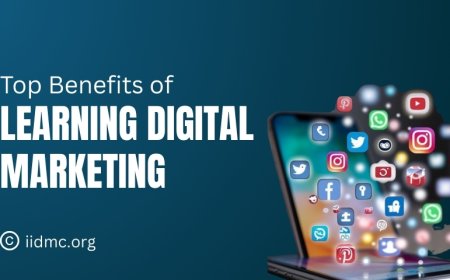Mastering Brand Management Basics
Learn the essentials of brand management, from building brand identity to maintaining consistency and connecting with customers. Discover strategies to strengthen your brand and create lasting impact in any market

Strong brand management has become essential for any business hoping to stand out and build loyalty. But what does brand management really involve, and why does it matter so much? Whether you're a student exploring marketing or a business owner wanting to create a memorable brand, mastering the basics of brand management can make a big difference. This blog will break down the core concepts, from understanding your audience to crafting a brand message that truly connects. We’ll explore simple, practical steps that anyone can follow to create and manage a brand that people will remember and trust.
What is Brand Management?
Brand management is about building, maintaining, and protecting a brand’s reputation to ensure it connects positively with its audience. It creates a consistent experience, helping customers recognize, trust, and choose the brand over others.
Purpose and Objectives
The goals of brand management include:
-
Building Brand Awareness: Making people familiar with the brand and what it offers.
-
Creating Brand Loyalty: Building customer trust to encourage repeat business.
-
Increasing Brand Value: Growing the brand’s worth to support premium pricing and investor interest.
-
Differentiating from Competitors: Making the brand memorable and distinct.
Roles of Brand Managers and Stakeholders
Brand managers oversee the brand’s image and strategy, ensuring messaging consistency and adjusting as needed. They collaborate with:
-
Marketing to spread the brand message.
-
Product Development to align products with brand values.
-
Sales to gather customer feedback.
-
Customer Support to represent the brand’s values in interactions.
Together, these roles create a cohesive brand that meets customer expectations and builds lasting trust.
Key Components of Brand Management
-
Brand Identity: How a brand presents itself visually—logos, colors, typography, and slogans—creating a recognizable look and feel that connects with customers. Examples include Apple’s sleek logo and Coca-Cola’s classic red and white theme.
-
Brand Positioning: Defines the brand’s unique place in the market. It answers questions like, “What makes this brand different?” Effective positioning helps customers see why this brand is a better choice than competitors.
-
Brand Equity: The value a brand builds over time through customer recognition, trust, and loyalty. Positive experiences and consistent quality grow brand equity, enabling brands like Nike to command premium prices.
-
Brand Personality: A brand’s “character” that resonates with its audience, such as Jeep’s adventurous spirit or Dove’s nurturing image. Brand personality helps create emotional connections with customers.
-
Brand Communication: How a brand interacts with its audience across channels (ads, social media, customer service). Consistent communication builds trust, reinforces values, and strengthens the brand’s identity.
These components together shape customer perception, build loyalty, and help the brand stand out in the market.
Why Brand Consistency is Crucial
Brand consistency ensures a unified look, message, and feel across all platforms, helping customers recognize and trust a brand. When visuals and messaging are consistent, the brand becomes memorable, strengthening customer loyalty.
Importance of Consistent Messaging and Visuals
Consistency across platforms builds recognition. For example, a sports brand that uses the same color scheme and energetic tone everywhere becomes instantly identifiable and reinforces its values.
Impact of Inconsistency on Credibility
Inconsistent branding can confuse customers, weaken trust, and make a brand appear unreliable. When a luxury brand’s high-end website is paired with unprofessional social media visuals, it risks losing credibility.
Tips for Ensuring Brand Consistency

-
Brand Guidelines: Develop guidelines for visuals, tone, and messaging to create a unified brand experience.
-
Standardized Visuals and Messaging: Use the same colors, fonts, and tone across all channels.
-
Regular Brand Audits: Check for inconsistencies in content regularly.
-
Team Training: Ensure all team members understand brand standards.
Brand consistency strengthens connections and builds a reliable, memorable brand image.
Building a Strong Brand Identity
A strong brand identity helps a brand stand out and connect with its audience. Here’s how to create one:
-
Define Mission and Values: Clearly state what the brand stands for and why it exists. This foundation guides all branding decisions.
-
Know Your Target Audience: Understand who you’re reaching, their needs, and what they value. This helps shape an identity that resonates.
-
Develop Visual Elements: Create distinct visuals—logos, colors, fonts—that reflect the brand’s personality. Memorable visuals make the brand recognizable.
-
Create a Consistent Brand Voice: Develop a tone that aligns with the brand’s character and use it consistently across channels.
-
Align with Audience Expectations: Ensure that visuals, messaging, and values reflect what your audience cares about, making the brand relatable and memorable.
By following these steps, brands can create a unique identity that resonates with their audience and stands out in the market.
Understanding and Building Brand Positioning
Brand positioning defines how a brand stands out in the market. Here’s how to create effective positioning:
-
Identify a Unique Selling Proposition (USP): Define what makes your brand unique and valuable to customers. Think about what problems you solve better than others or unique qualities only your brand offers.
-
Conduct Competitive Analysis and Market Research: Study competitors and understand customer preferences to find your brand’s unique place in the market.
-
Create a Positioning Statement: Keep it clear, specific, and memorable. Highlight the USP and focus on the main benefit customers get from choosing your brand.
Example: "For busy professionals, our service delivers fresh, organic meals to keep you energized and productive."
By defining a USP and crafting a simple positioning statement, a brand can establish a unique, appealing position in the market.
Developing Brand Loyalty and Trust
Building loyalty and trust means creating genuine connections with customers:
Emotional Connections: Engage with customers authentically through stories and content that reflect the brand’s values and resonate with their lives.
Customer Service: Positive, responsive support builds trust and encourages repeat business. Great service shows customers they are valued.
Social Proof and User-Generated Content: Share customer reviews, testimonials, and photos to build trust. User-generated content provides relatable, real-world validation of the brand.
These strategies help create a loyal customer base that trusts and supports the brand.
Brand Communication and Messaging
Effective brand communication strengthens connections with customers by conveying the brand’s story and values clearly and consistently.
-
Importance of Brand Storytelling
Storytelling helps customers relate to the brand on a personal level. Sharing stories about the brand’s mission, history, or impact creates an emotional connection, making customers feel more invested. -
Tips for Clear, Consistent Messaging
Use a unified tone and language across all channels. Keep messages simple and focused on core brand values, ensuring they reflect the brand’s personality. Consistency builds recognition and trust. -
Social Media and Content Marketing
Social media and content marketing allow for engaging communication. Sharing valuable, relatable content on platforms where customers spend time helps keep the brand top of mind and strengthens its presence.
These strategies ensure that a brand’s message resonates, building a lasting connection with its audience.
Measuring Brand Success
Tracking brand success involves monitoring key metrics to understand brand impact and customer relationships.
-
Key Metrics and KPIs
-
Brand Awareness: Measured through surveys, social reach, and search volume to assess visibility.
-
Customer Loyalty: Use repeat purchase rate, customer lifetime value, and retention rate to gauge loyalty.
-
Engagement: Track likes, shares, comments, and website interactions to see how well content resonates.
-
Customer Feedback and Brand Perception
Collecting customer feedback helps understand how customers view the brand. Surveys, reviews, and sentiment analysis tools reveal brand strengths and areas for improvement. -
Tools for Tracking Performance
Use tools like Google Analytics, Brandwatch, and Sprout Social to monitor metrics, analyze engagement, and track brand perception across platforms.
Common Brand Management Challenges and Solutions
-
Evolving Market Trends
-
Challenge: Keeping up with new trends to stay relevant.
-
Solution: Conduct regular market research and stay informed about industry developments. Adapt the brand message and products to align with customer expectations.
-
Managing Negative Feedback
-
Challenge: Addressing and responding to negative reviews.
-
Solution: Respond promptly and professionally to feedback. View criticism as an opportunity to improve and showcase customer care.
-
Staying Relevant
-
Challenge: Ensuring the brand remains meaningful as customer preferences change.
-
Solution: Continuously gather customer insights, refresh branding when needed, and innovate to meet evolving needs. Adaptability and innovation keep brands resilient.
Best Practices for Mastering Brand Management
-
Develop a Strong Brand Strategy
A well-defined strategy that aligns with business goals is essential for guiding all brand decisions. -
Conduct Regular Brand Audits
Regularly review brand materials, messaging, and customer perceptions to ensure consistency and effectiveness. -
Continuous Learning
Stay updated on branding trends, tools, and best practices. Attend workshops, read industry news, and adapt to new insights.
These practices help new brand managers build and maintain a successful brand, ensuring its growth and relevance over time.
Mastering the basics of brand management is essential for building a strong, recognizable brand that connects with customers. Effective brand management helps create lasting impressions, foster loyalty, and set a brand apart from competitors. By focusing on core elements like brand identity, positioning, and communication, businesses can create a trusted image that resonates with their audience.
Investing in brand management brings significant rewards, including increased customer trust, brand loyalty, and market presence. Starting with simple steps—such as defining your brand’s values, crafting consistent messaging, and gathering customer feedback—can lay the foundation for a successful brand. To deepen your skills, consider professional training like the IIDMC Certification from the International Institute of Digital Marketing Certification IIDMC, which provides comprehensive guidance on brand management strategies. Keep learning and adapting, as continuous improvement is key to mastering brand management over time.





























